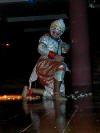|
Khon (โขน)
Thai. Classical
dance theater, typically with themes from the
Ramakien, performed by dancers
dressed in
rich
embroidered
brocade
(fig.)
costumes,
each representing a character from the Ramakien.
The
human
characters wear
either a
khon mask
(fig.)
or a
chadah
(fig.),
and the
dancers
representing
demons
or
monkeys
wear masks in a variety of colors and shapes according to their
character.
A singer
called phu phaak khon
recites
the story in verse
while the show is proceeding on the stage.
By means of a
complex combination
of
mudra
(fig.)
and positions
of the body, different
situations,
thoughts and feelings are expressed.
Every hand position has, in
combination with the
position of the body,
referred to as
ram tha, an exact defined meaning. The
Sanskrit word mudra,
usually translated as
‘hand
position’
and also applied in Buddhist
iconography,
literally means
‘seal’
or
‘print’.
Only experienced
Khon
adepts
are able to distinguish the many gestures and their
nuances.
In Khon,
officially
all roles
including the
female parts
are played by men.
The
complete
version
of the
Ramakien consists of
311 characters and an
uninterrupted
performance (fig.)
would last more than a month.
Miniature models of khon masks are a popular collector's item and souvenir (fig.).
In
Bang Pa-in, in
Ayutthaya province, is the
Khon Learning Centre (fig.), known in Thai as Ahkahn Rian Roo Reuang Khon (อาคารเรียน-รู้-เรื่องโขน), literally
‘Learning About Khon Building’, a museum that houses a collection of large decors used on khon stages, as well as of khon masks, costumes,
rajarot and stage props, and educates visitors on anything about this classical
dance and its theater. On the outside, the pillars on the balcony of the building front are decorated with figures of the Ramakien. In
Cambodia,
Apsara Dance (fig.)
is the
Khmer
equivalent of Khon, and is named
after the
Apsara (fig.),
i.e. female divinities or nymphs
that perform as
the
celestial dancers of the
Tavatimsa
Heaven.
Pronunciation ‘khoon’ and sometimes transcribed khohn or
kone.
See also
National Theatre.
See also LIST OF RAMAKIEN CHARACTERS & PLACE NAMES.
回






|

